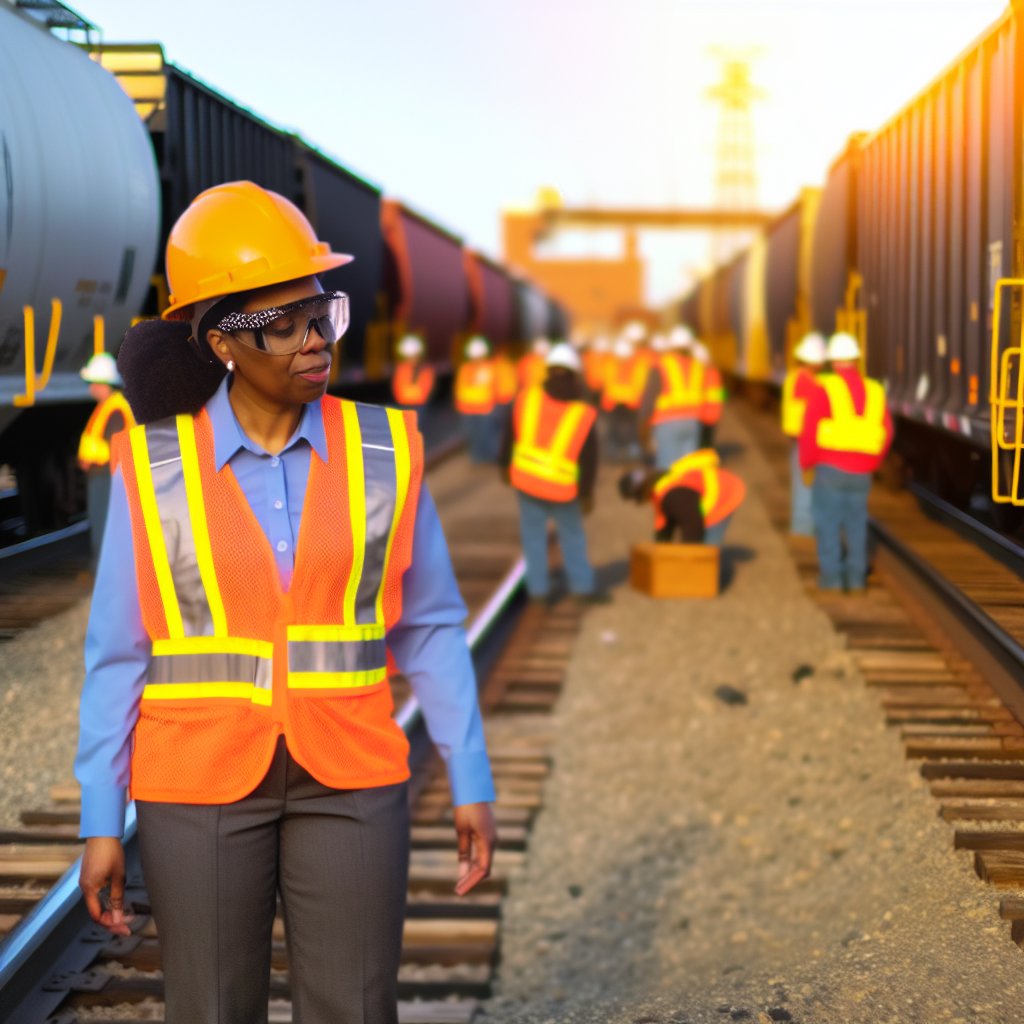Introduction:
Worksite safety for rail yard engineers is crucial to prevent accidents and injuries.
Following best practices is key.
Importance of Personal Protective Equipment (PPE)
Wearing PPE such as helmets, gloves, and safety glasses is essential for protection.
Proper Communication Practices
Clear and effective communication with team members can prevent misunderstandings and potential accidents.
Regular Equipment Inspection
Inspecting equipment regularly ensures that it is in good working condition and reduces the risk of malfunctions.
Training and Education
Ongoing training and education on safety protocols and procedures is necessary to keep engineers informed and prepared.
Emergency Response Planning
Having a well-defined emergency response plan in place ensures quick and effective action in case of any unforeseen events.
Safe Handling of Hazardous Materials
Proper training and practices for handling hazardous materials prevent exposure and potential risks to health.
Adherence to Speed Limits
Following speed limits within the rail yard reduces the chances of collisions and ensures safe operations.
Maintaining a Clean and Organized Work Environment
A clean and organized work environment minimizes trip hazards and promotes overall safety for everyone in the yard.
Wearing Personal Protective Equipment (PPE)
It is crucial for rail yard engineers to always wear Personal Protective Equipment (PPE) while on the job.
PPE includes items like hard hats, safety glasses, and steel-toed boots.
Importance of Wearing PPE
Protection from Falling Objects: Rail yard engineers work in environments where there is a risk of objects falling from above.
Wearing a hard hat can help prevent head injuries in case of accidents.
Shield from Sharp Materials: In a rail yard setting, there are often sharp materials and debris present that could cause cuts or puncture wounds.
Safety glasses can protect the eyes from these hazards.
Emphasizing the Importance of PPE
Safety First: By wearing PPE, rail yard engineers prioritize their safety and well-being while performing their duties.
It creates a barrier between them and potential harm.
Compliance with Regulations: Many workplaces have strict rules regarding the use of PPE.
Transform Your Career Today
Unlock a personalized career strategy that drives real results. Get tailored advice and a roadmap designed just for you.
Start NowBy adhering to these regulations, engineers contribute to a culture of safety and compliance.
Taking Steps to Protect Oneself
Proper Fit: It is essential that all PPE items fit correctly and comfortably.
Ill-fitting gear can be distracting and may not provide adequate protection in case of an accident.
Regular Inspections: Rail yard engineers should routinely inspect their PPE for signs of wear or damage.
Damaged equipment should be replaced immediately to ensure continued protection.
Training and Education: Employers should provide comprehensive training on the proper use and care of PPE.
Engineers must understand the importance of wearing these items and how they contribute to their safety.
Wearing Personal Protective Equipment is a fundamental aspect of maintaining a safe work environment in rail yards.
It is a simple yet effective way to mitigate common hazards and protect the well-being of engineers on-site.
Why Engineers Must Adhere to Safety Protocols
Prevention of accidents is vital for every workplace.
Protection of lives and property must always be a priority.
Maintaining operational efficiency contributes to overall safety.
Compliance with industry regulations is essential for safety.
Failure to follow these safety procedures can have serious consequences.
Derailments and collisions can occur if safety is disregarded.
Injuries and fatalities can have a devastating impact.
Disregarding safety protocols puts everyone in the vicinity at risk.
Significant damage to equipment and infrastructure can result from negligence.
Dangers of Disregarding Safety Procedures
- Potential for derailments
- Risk of collisions
- Increased likelihood of injuries
- Potential damage to property
Engineers must prioritize safety above all else.
Making safety a top priority enhances daily work routines.
Transform Your Career Today
Unlock a personalized career strategy that drives real results. Get tailored advice and a roadmap designed just for you.
Start NowBy following proper locomotive safety procedures diligently, they can prevent accidents.
This creates a secure working environment for themselves and their colleagues.
Find Out More: Essential Tools and Equipment for Freight Handlers
Maintain a Clean and Organized Worksite:
Keeping the rail yard free of clutter and debris is crucial for ensuring the safety of engineers.
By maintaining a clean and organized worksite, we can prevent accidents and create a more efficient working environment.
Significance of Keeping the Rail Yard Free of Clutter:
- Clutter and debris can pose serious hazards to engineers working in the rail yard.
- Tripping over items left on the tracks or along walkways can result in injuries.
- Loose materials can also be a fire hazard, especially in close proximity to trains and engines.
- Having a clutter-free environment allows for easier movement of equipment and tools.
Preventing Tripping Hazards:
- A clean worksite reduces the risk of engineers tripping over objects or uneven surfaces.
- Regular inspection and removal of debris can prevent accidents before they happen.
- Strategically placed trash bins and designated storage areas can help keep the area organized.
- Proper lighting around the rail yard can also help in identifying potential tripping hazards.
Improving Overall Safety for Engineers:
- Engineers can focus on their tasks more effectively in a clean and organized environment.
- Reducing clutter minimizes distractions and allows for better concentration on the job at hand.
- Increased safety measures lead to improved morale among workers and a positive work culture.
- Regular training on the importance of maintaining a clean worksite can instill a sense of responsibility among employees.
By emphasizing the importance of keeping the rail yard free of clutter and debris, we can create a safer and more efficient work environment for engineers.
Implementing regular cleaning schedules, providing proper storage solutions, and promoting a culture of cleanliness can go a long way in preventing accidents and ensuring the well-being of all workers.
Explore Further: Risk Management Strategies in Logistics Operations
Importance of Regular Safety Training
One of the most crucial aspects of ensuring the safety of rail yard engineers is to conduct regular safety trainings.
Recommend Regular Safety Training:
- Suggest that rail yard companies prioritize ongoing safety training for their engineers.
- Emphasize the importance of continuous learning and updating knowledge on safety protocols.
- Regular training sessions help engineers stay informed about the latest safety standards and procedures.
Benefits of Regular Training:
- Increased Awareness of Hazards: Regular safety trainings enhance the engineers’ understanding of potential workplace hazards.
- Improved Implementation of Best Practices: Training sessions reinforce the importance of following safety protocols and best practices.
- Enhanced Emergency Response: Regular training equips engineers with the necessary skills to respond effectively in case of emergencies.
- Reduced Accidents and Incidents: Well-trained engineers are less likely to be involved in accidents or incidents in the rail yard.
By investing in regular safety trainings, rail yard companies can ensure that their engineers are well-prepared to handle any safety challenges that may arise in the workplace.
See Related Content: Work-Life Balance Tips for Logistics Consultants
Communicate Effectively with Team Members:
Effective communication is a vital aspect in ensuring safety at the rail yard.
When engineers and other workers communicate clearly and effectively, it helps in preventing accidents and promoting a safer work environment.
Here are some key points to consider when it comes to communicating effectively with team members:
Importance of Clear Communication:
Clear communication among team members is crucial to ensure that everyone understands their roles, responsibilities, and tasks.
It helps in avoiding confusion and mitigating potential risks that can arise due to misinterpretations or misunderstandings.
By communicating clearly, engineers can ensure that everyone is on the same page and working towards the common goal of maintaining a safe worksite.
Preventing Misunderstandings:
Misunderstandings can lead to errors, accidents, and delays in work progress.
By communicating effectively, engineers can clarify instructions, provide updates on work status, and address any concerns or questions that team members may have.
This can help in avoiding miscommunication that could result in unsafe work practices or inadequate coordination among workers.
Transform Your Career Today
Unlock a personalized career strategy that drives real results. Get tailored advice and a roadmap designed just for you.
Start NowImproving Overall Worksite Safety:
Effective communication plays a key role in enhancing worksite safety.
By keeping everyone informed and engaged, engineers can ensure that safety protocols are followed, potential hazards are identified and addressed, and emergency procedures are understood by all team members.
Clear communication fosters a culture of safety awareness and promotes a collaborative approach to maintaining a safe work environment.
By prioritizing communication among team members, engineers can create a safer and more productive work environment where everyone is informed, engaged, and committed to upholding safety standards.
Investing time and effort in improving communication skills can lead to better safety outcomes and contribute to a positive work culture where safety is a top priority.
You Might Also Like: Freight Agent Career Longevity and Stability

Inspect Tools and Equipment Regularly:
- Encourage engineers to inspect tools and equipment before and after each use.
- Regular inspections can identify potential hazards and prevent accidents related to faulty equipment.
Inspecting tools and equipment regularly is a crucial aspect of ensuring safety in a rail yard engineer worksite.
By encouraging engineers to inspect their tools and equipment before and after each use, you can significantly reduce the risk of accidents and injuries.
Regular inspections help in identifying any potential hazards that may be present due to faulty equipment.
By checking for any signs of wear and tear, damage, or malfunctions, engineers can take proactive measures to address these issues before they lead to accidents.
When tools and equipment are not properly maintained, they can pose serious safety risks to the engineers working in the rail yard.
A simple inspection routine can make a significant difference in preventing accidents and ensuring a safe working environment for all employees.
Benefits of Regular Inspection:
- Prevent accidents caused by faulty equipment.
- Identify potential hazards before they become a safety risk.
- Extend the lifespan of tools and equipment through proper maintenance.
- Ensure the safety and well-being of engineers working in the rail yard.
By emphasizing the importance of regular inspections to your team of engineers, you can instill a safety-conscious mindset and create a culture of accountability when it comes to maintaining tools and equipment.
Encouraging open communication and feedback can also help in identifying areas for improvement and addressing any concerns promptly.
Making regular inspections a standard practice in your rail yard engineer worksite can significantly enhance safety, prevent accidents, and promote a healthy work environment for everyone involved.
Implement Emergency Response Plans:
Rail yard companies must develop and implement emergency response plans for various scenarios.
These plans should outline step-by-step procedures that need to be followed in case of emergencies.
Having an emergency response plan in place ensures that employees are well-prepared to handle accidents, spills, or other emergency situations that may arise in the workplace.
This proactive approach can help minimize the impact of such incidents and ensure the safety of everyone involved.
Key Points to Consider in Emergency Response Plans:
- Identification of Potential Risks:
- Conduct a thorough assessment of the rail yard to identify potential risks and hazards that could lead to emergencies.
- This includes identifying areas where accidents are more likely to occur and taking necessary precautions to mitigate those risks.
- Emergency Contact Information:
- Ensure that all employees have access to emergency contact information, including phone numbers for local emergency services and key personnel within the company.
- This information should be easily accessible and regularly updated to ensure its accuracy in case of emergencies.
- Communication Protocols:
- Establish clear communication protocols that outline how information should be disseminated in the event of an emergency.
- This could include using various communication channels such as radios, phones, or intercom systems to relay important messages quickly and effectively.
- Training and Drills:
- Conduct regular training sessions and drills to prepare employees for emergency situations.
- Practice scenarios such as fires, chemical spills, or derailments to ensure that everyone knows their role and responsibilities in such incidents.
- Equipment and Resources:
- Ensure that the rail yard is equipped with necessary resources and equipment to handle emergencies effectively.
- This includes having first aid kits, fire extinguishers, spill containment materials, and other tools readily available in strategic locations throughout the yard.
- Coordination with Local Authorities:
- Establish partnerships with local emergency response agencies and authorities to facilitate a coordinated response in case of emergencies.
- This collaboration can help streamline communication and ensure a timely and efficient response to critical situations.
Implementing emergency response plans is crucial for ensuring the safety of rail yard employees and minimizing the impact of emergency situations.
Transform Your Career Today
Unlock a personalized career strategy that drives real results. Get tailored advice and a roadmap designed just for you.
Start NowBy proactively preparing for potential risks and hazards, companies can create a safer work environment for everyone involved.
Remember, preparedness is key in handling emergencies effectively.
Safety Practices for Rail Yard Engineers
It is crucial for rail yard engineers to prioritize safety at all times.
By implementing best practices such as conducting regular safety inspections, wearing appropriate protective gear, and communicating effectively with team members, accidents and injuries can be prevented.
Following safety protocols not only ensures the well-being of the engineers but also contributes to the overall efficiency of operations in the rail yard.
It is everyone’s responsibility to adhere to safety guidelines and promote a culture of safety in the workplace.
Additional Resources
Transportation & Infrastructure | Industries | Holland & Knight
Gary Mang on LinkedIn: #buildingamerica #railroad #transportation …




